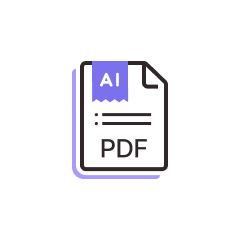Extract PDF Data Using AI – Free Template
Use this template to automatically pull data from PDF files with AI. Simplify document parsing and export structured results instantly.

Use this template to automatically pull data from PDF files with AI. Simplify document parsing and export structured results instantly.









Parabola's PDF handling capabilities enable you to extract and transform data from PDF documents efficiently.
Parabola's PDF data extraction functionality enables you to convert PDF documents into structured, analyzable data. The platform can handle various PDF formats and layouts, making it versatile for different business needs.
The Extract with AI step in Parabola leverages large language models to intelligently parse and extract specific values from your API data. This powerful feature can understand context and identify patterns in your data, making it ideal to extract data from any PDF.
Here are a few examples of how you can use Parabola to automatically extract data from PDFs:
Many businesses receive invoices in PDF format from their vendors or customers. By using Parabola's Pull from PDF fi anExtract with AI steps, you can automatically extract key data from these invoices, such as the total amount, due date, and line item details. This can help you streamline your accounts payable and receivable processes.
Organizations often receive financial reports in PDF format, such as quarterly earnings reports or annual reports. Using Parabola, you can extract the key financial metrics from these reports, apply custom calculations, and visualize the data to gain deeper insights into the organization's performance.
Many organizations use PDF forms to collect data from customers, employees, or other stakeholders. By using Parabola's Pull from PDF fi anExtract with AI steps, you can automatically extract the data from these forms and integrate it into your existing systems, reducing the need for manual data entry.
In conclusion, using Parabola to automatically extract data from PDF files can save you time, reduce errors, and improve the accuracy of your data-driven processes. By leveraging the power of AI-powered data extraction, you can unlock valuable insights and streamline your workflows.
____________________________________
It works with both searchable and scanned PDFs, including invoices, packing lists, reports, forms, receipts or any document that contains data you want to convert into structured output.
Not necessarily. You upload your PDF, then configure the “Extract with AI” step to identify the fields you want. The AI handles much of the layout variation, and you only refine when formats change or are highly irregular.
Yes. Once your workflow is set up, you can schedule or trigger it so new PDFs (e.g., in a folder or inbox) are processed automatically, and data flows out without manual intervention.
After extraction you can export your data into XLSX, CSV, or feed it into downstream systems, BI dashboards, or databases—whatever format your workflow requires.
Accuracy depends on the quality and consistency of the PDF content. The AI is designed to handle tables, multi-page documents, and varied layouts, giving you a preview to adjust before final export.
If layouts change, you may need to update mappings or refine extraction rules. However the AI is resilient to variation, so many changes will be handled automatically without full rebuilds.
No. The tool is designed for no-code use: drag-and-drop steps in the workflow, upload your PDFs, define your output fields, and you’re running. Tech or data-engineering resources not required.
Yes. You can batch-upload many files or monitor a folder/ingestion source, apply the extraction workflow, and process hundreds or thousands of pages in one run.
Absolutely. Documents like freight invoices, bills of lading, packing lists, POs and audit forms are typical use cases — the tool turns them into structured, actionable data for reporting and automation.
It saves manual copy-pasting, reduces errors, handles varied formats without brittle templates, accelerates processing time, and frees your team to focus on insights rather than data collection.








Request a demo and see how Parabola can automate
your most manual SOPs.